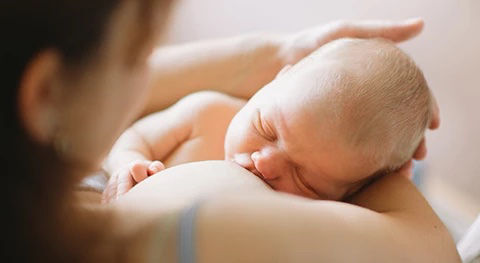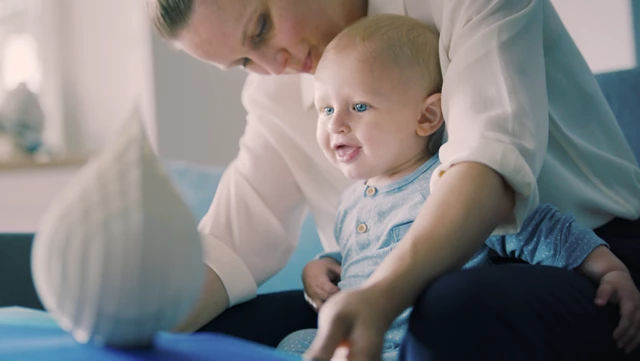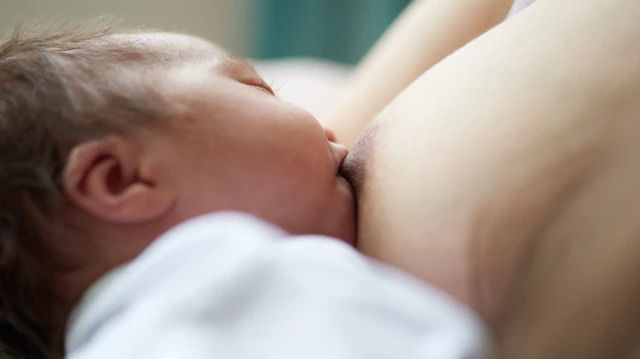Common breastfeeding problems
From sore nipples and leaking breasts, to problems latching on, many mums encounter breastfeeding issues in the early stages. Just like any new skill, breastfeeding can take a while to master. But it is well worth persevering as it provides tailor-made nutrition for your baby.

Can all women breastfeed?
Yes, almost every woman can breastfeed 3. However, breastfeeding can take time and practice to perfect, just like any new skill, and it’s not uncommon for new mothers to experience breastfeeding problems, like breastfeeding pain. But the more time you spend in close contact with your baby, the more you’ll get to know and understand each other’s signals. Your breast milk is the only food that’s designed for your baby and can help to protect them against infections. That’s why it’s especially important to persevere in the early stages.

If you’re having any sort of issues with breastfeeding, speak to your midwife or health visitor as soon as you can. You’ll find that there are many local breastfeeding support networks that will be happy to offer help and support too. Or you can talk to one of our expert feeding advisors at Aptaclub, anytime, on 0800 996 1000. Here are some common problems and advice we have to help you have the most successful breastfeeding experience you can.
Common Feeding Problems

- Sore nipples are a common breastfeeding problem; this may be due to your baby not latching on properly or being in the wrong position. Read our guide on breastfeeding positions for advice on how to adapt your feeding position for your comfort.
- To prevent soreness try squeezing out a drop of milk after you feed and rubbing it into your skin, letting your nipples dry before you cover them. If you’re using breast pads in your bra, remember to change them after every feed and opt for a cotton bra, which will let the air circulate.
- If you’re experiencing shooting pains in your breasts during feeding there is a possibility that you might both have thrush. It’s a common infection that’s easily treated. Just visit your doctor who should prescribe something for you both to clear it up.
- A couple of days after birth, it’s common for your breasts to become full and swollen. This can cause breast pain while breastfeeding. This is due to your body producing an abundance of milk, and increased blood flow to the area.
- A warm bath or shower before feeding can encourage the milk to flow, while massaging the breast you’re feeding from can help to relieve some of the tightness. You could also try applying cold packs to soothe your breasts and provide some relief from discomfort. But the best way to ease the full, swollen feeling and to relieve the pressure is to feed regularly – in time your body will adjust to your baby’s needs.
- This can occur after your breast being too engorged, therefore follow the advice above first.
- It is also best to get your baby to feed with their chin facing your blockage (where you feel a small lump), and this should relieve the blockage.
- If this leads to increased pain and other symptoms it could be mastitis.
- When your breasts are full of milk, it’s not unusual for them to leak. It can also happen unexpectedly when your body’s letdown reflex is triggered by a baby’s cry – whether yours or someone else’s. It’s most common during the first few weeks of breastfeeding, while your body adapts to your baby’s feeding routine.
- There’s no way of controlling leaks. But feeding frequently and before your breasts are full can help. And once breastfeeding is established, leaking will reduce. Breast pads for your bra are designed to absorb any leaks and come in disposable or washable varieties. By carrying a spare pair and a change of top, you’ll be prepared if there’s a mishap!
Read our guide on how to help increase milk supply
- It is not true that inverted nipples can’t breastfeed, as your baby will latch onto your areola (dark area around your nipple) and not your nipple itself4.
- If you believe your baby can’t breastfeed, try using a different position which is easier for them to latch on.
- If you believe your baby is having an allergic reaction to your breast milk, speak to a health care professional immediately.
- Cow’s milk allergy is an allergy more common in children that adults, see our page on Cow’s milk allergy for more advice.
Last reviewed: 13th July 2020
Reviewed by Nutricia’s Medical and Scientific Affairs Team
The science behind your let-down reflex, Powered by Nutricia
Your let-down reflex is essentially the reflex in your body which releases the milk in your breasts, making it available to your baby. This can be triggered by your baby sucking at your breast, or the sound of a baby crying. These actions prompt your body to release oxytocin hormones into your bloodstream, which in turn causes the cells around your milk ducts to contract, and your breasts to push out or ‘let down’ your breast milk5.
Related articles

Need some help?
You can get quick answers to common questions in our FAQs.
Alternatively, if you need help with general pregnancy or baby advice, or maybe on using or ordering our products - our expert team are always on hand to talk about feeding your baby.
- Colson, S. Maternal breastfeeding positions: Have we got it right? (2). The Practising Midwife, 2005;8(11):29-32.
- Colson, S., Meek, J. and Hawdon, J. Early Hum Dev, 2008;84(7):441-449.
- Puapornpong, P., et al. Breastfeed Med, 2017;12(4):233-237.
- Thomson, S. J Hum Lact, 2013;29(2):147-149.
- WHO (2009) Infant And Young Child Feeding: Model Chapter For Textbooks For Medical Students And Allied Health Professionals. Geneva.








